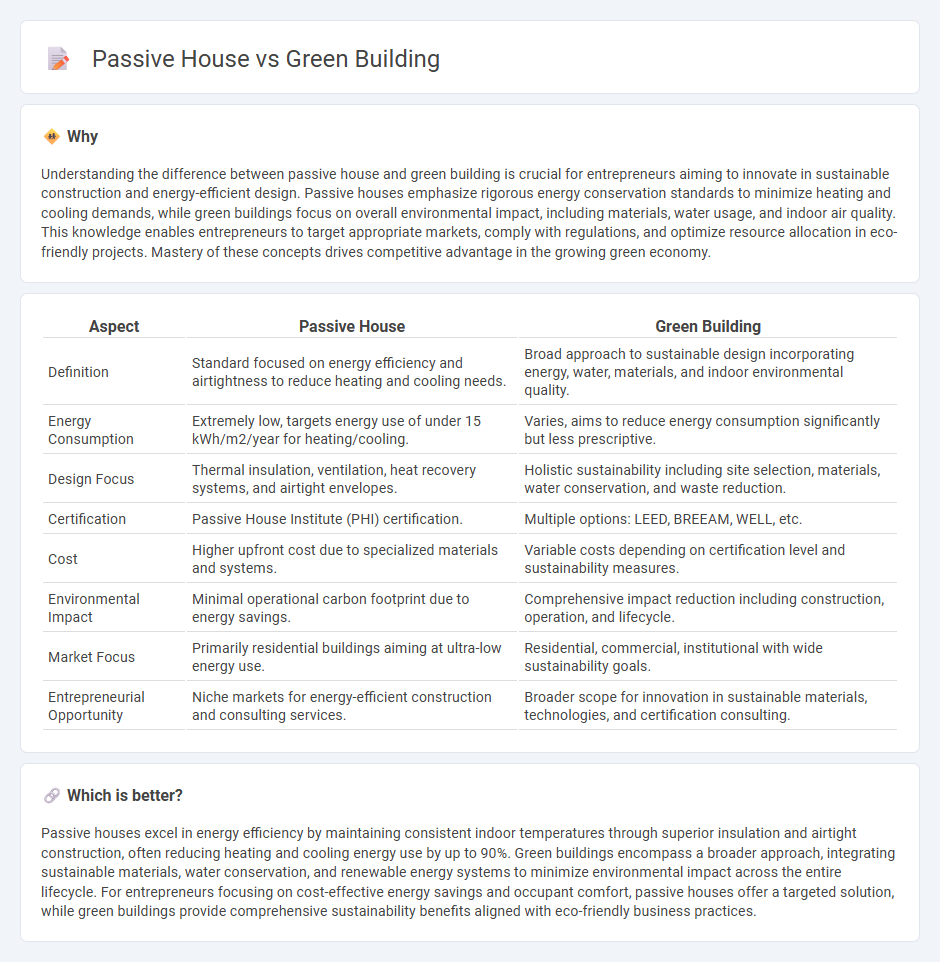
Passive houses focus on ultra-efficient energy use through airtight construction and high insulation standards, drastically reducing heating and cooling demands. Green buildings encompass a broader range of sustainable practices, including resource-efficient materials, water conservation, and renewable energy integration, aiming to minimize overall environmental impact. Discover how these innovative approaches transform the future of sustainable architecture.
Why it is important
Understanding the difference between passive house and green building is crucial for entrepreneurs aiming to innovate in sustainable construction and energy-efficient design. Passive houses emphasize rigorous energy conservation standards to minimize heating and cooling demands, while green buildings focus on overall environmental impact, including materials, water usage, and indoor air quality. This knowledge enables entrepreneurs to target appropriate markets, comply with regulations, and optimize resource allocation in eco-friendly projects. Mastery of these concepts drives competitive advantage in the growing green economy.
Comparison Table
| Aspect | Passive House | Green Building |
|---|---|---|
| Definition | Standard focused on energy efficiency and airtightness to reduce heating and cooling needs. | Broad approach to sustainable design incorporating energy, water, materials, and indoor environmental quality. |
| Energy Consumption | Extremely low, targets energy use of under 15 kWh/m2/year for heating/cooling. | Varies, aims to reduce energy consumption significantly but less prescriptive. |
| Design Focus | Thermal insulation, ventilation, heat recovery systems, and airtight envelopes. | Holistic sustainability including site selection, materials, water conservation, and waste reduction. |
| Certification | Passive House Institute (PHI) certification. | Multiple options: LEED, BREEAM, WELL, etc. |
| Cost | Higher upfront cost due to specialized materials and systems. | Variable costs depending on certification level and sustainability measures. |
| Environmental Impact | Minimal operational carbon footprint due to energy savings. | Comprehensive impact reduction including construction, operation, and lifecycle. |
| Market Focus | Primarily residential buildings aiming at ultra-low energy use. | Residential, commercial, institutional with wide sustainability goals. |
| Entrepreneurial Opportunity | Niche markets for energy-efficient construction and consulting services. | Broader scope for innovation in sustainable materials, technologies, and certification consulting. |
Which is better?
Passive houses excel in energy efficiency by maintaining consistent indoor temperatures through superior insulation and airtight construction, often reducing heating and cooling energy use by up to 90%. Green buildings encompass a broader approach, integrating sustainable materials, water conservation, and renewable energy systems to minimize environmental impact across the entire lifecycle. For entrepreneurs focusing on cost-effective energy savings and occupant comfort, passive houses offer a targeted solution, while green buildings provide comprehensive sustainability benefits aligned with eco-friendly business practices.
Connection
Passive house and green building share a focus on sustainability and energy efficiency, driving innovation in eco-friendly construction. Entrepreneurs in the green building sector leverage passive house principles to reduce energy consumption, lower carbon footprints, and create healthier indoor environments. This integration fosters market opportunities for sustainable materials, smart technologies, and renewable energy solutions.
Key Terms
Energy Efficiency
Green buildings incorporate sustainable materials and energy-efficient systems to reduce environmental impact, while passive houses emphasize airtight construction, superior insulation, and passive solar design to minimize energy consumption. Passive houses achieve up to 90% energy savings compared to traditional buildings by optimizing thermal performance and ventilation. Discover how each approach transforms energy efficiency in modern construction.
Sustainability
Green buildings incorporate sustainable materials, energy-efficient systems, and environmentally-friendly design principles to minimize ecological impact. Passive houses adhere to rigorous energy-saving standards, using advanced insulation, airtight construction, and heat recovery ventilation to achieve near-zero energy consumption. Explore the differences and benefits of these sustainable building approaches to enhance eco-friendly living.
Certification Standards
Green Building certification standards such as LEED and BREEAM emphasize sustainable site development, water savings, energy efficiency, material selection, and indoor environmental quality, promoting overall environmental impact reduction. Passive House certification specifically targets rigorous energy efficiency metrics, such as ultra-low heating and cooling demands, airtightness, and thermal comfort, ensuring minimal operational energy use. Explore the detailed criteria and benefits of each certification to determine which aligns best with your sustainable building goals.
Source and External Links
What Is Green Building? - IBM - Green building is a resource-efficient construction approach considering environmental impact and human health across a building's lifecycle, emphasizing energy and water efficiency, indoor environmental quality, and carbon emission reduction, often guided by standards like LEED.
Green Buildings | PNNL - Green buildings minimize negative environmental and health impacts by efficiently using energy, water, and materials, integrating renewable technologies, and improving indoor environments, aiming to reduce the building sector's large energy consumption and emissions.
Green building - Wikipedia - Green building combines sustainable design principles like bioclimatic design to reduce energy use and emissions, extending to neighborhoods and villages to create self-sufficient and zero energy communities.
 dowidth.com
dowidth.com